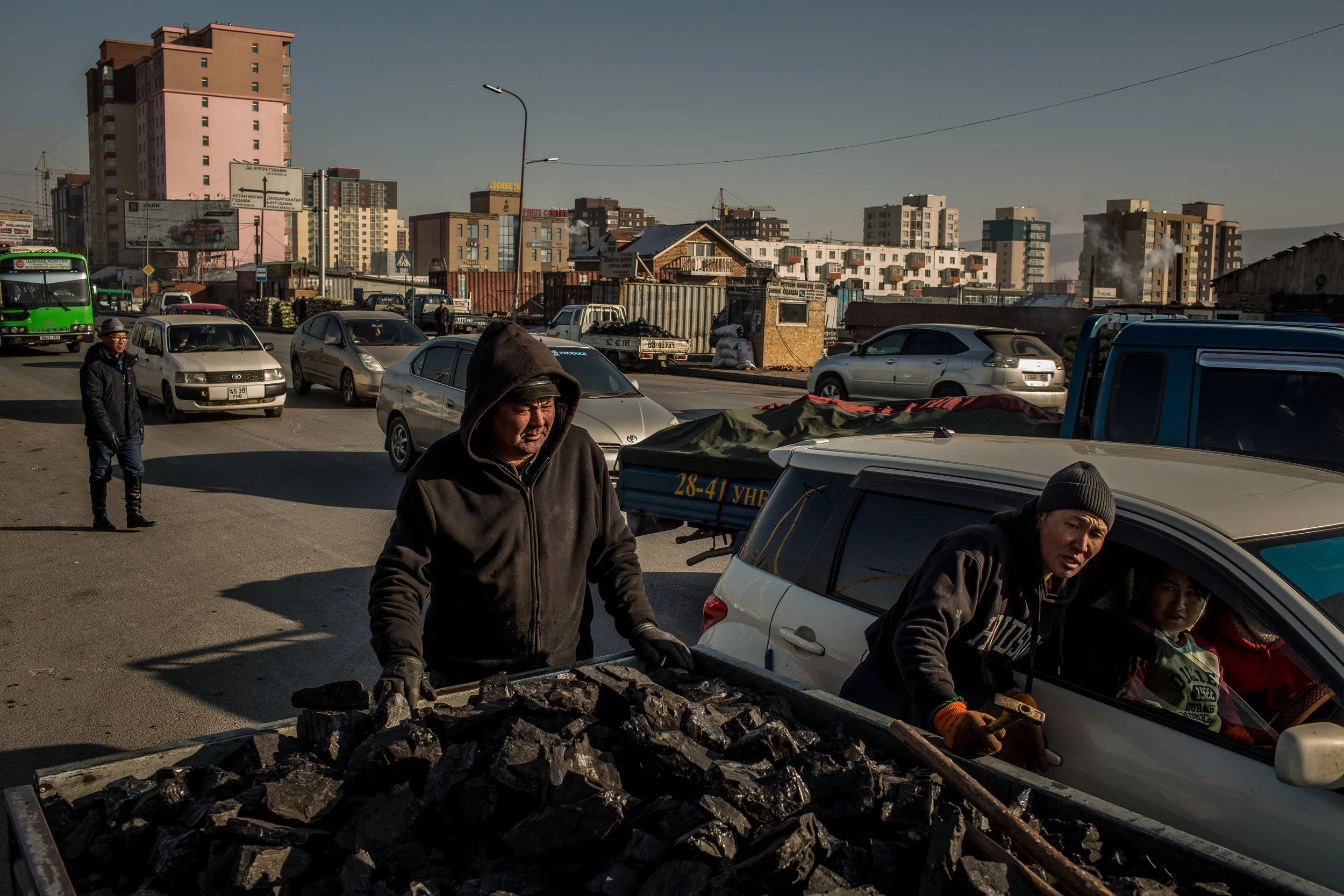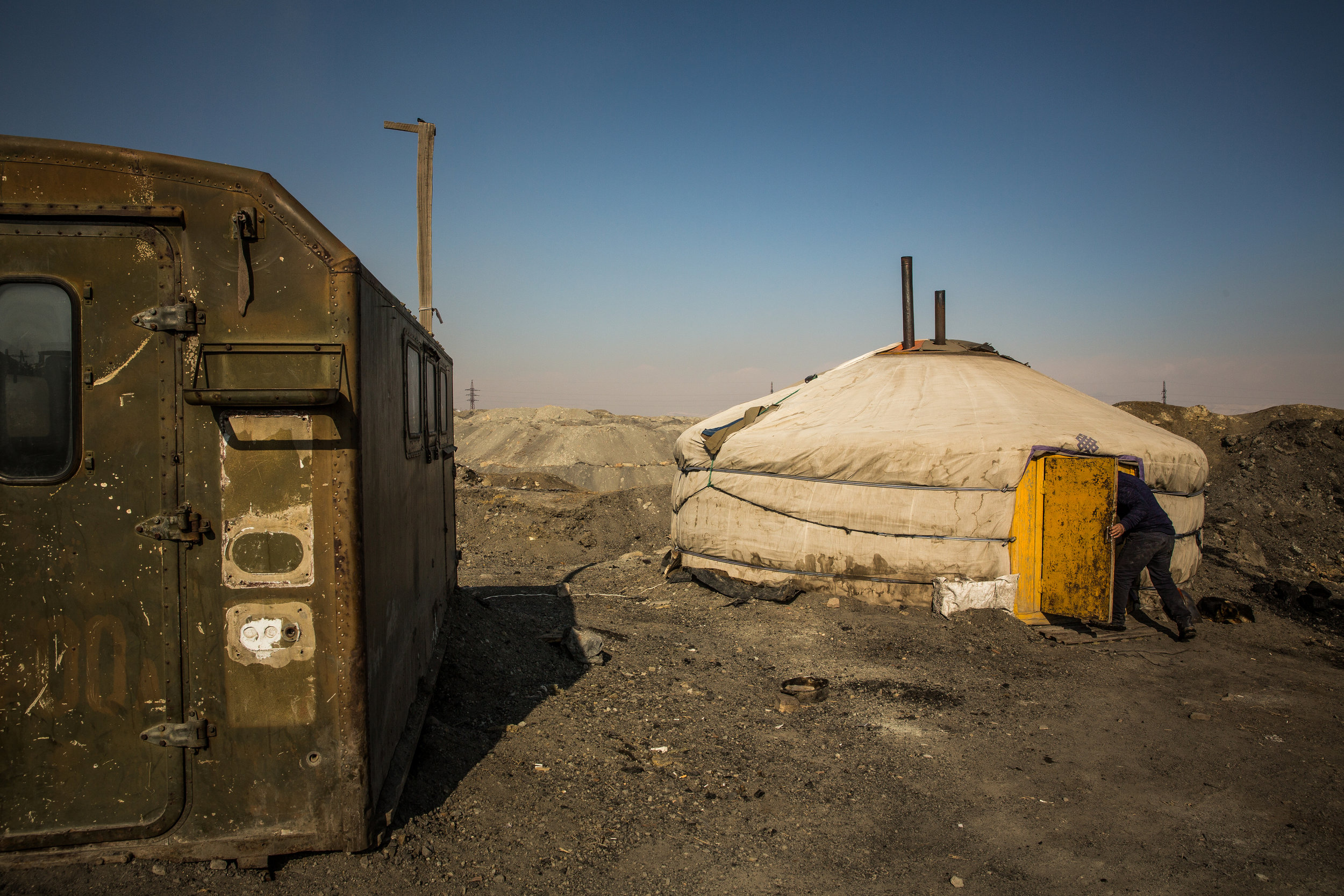














2/22/2018 Ulaanbaatar, Mongolia
A resident walked through smoke filled streets at 7pm in Dari Ekh, one Ulaanbaatar's unplanned Ger districts, as homes spewed coal smoke int the background. Breakfast and dinner time are peak hours for pollution in Ulaanbaatar during the winter, as people wake up to the bone chilling cold, or arrive home to cook dinner and warm a Ger for the approaching night. In the absence of air filtration, or properly weather sealed structures, the air quality inside frequently approaches that of the air outside.

2/20/2018 Ulaanbaatar, Mongolia
A group of men from western Mongolia staged an ice archery tryout for an upcoming competition on the frozen Tuul river, which runs through the southern section of Ulaanbaatar, earlier in February. During the winter, the river freezes so thoroughly that one can drive a Toyota Land Cruiser on top of the ice without much concern.

2/21/2018 Ulaanbaatar, Mongolia
Residents walked through the Bayankhoshuu District of northern Ulaanbaatar, Mongolia, during a polluted morning in mid February when the air quality index soared to 1426—nearly 57 times what the WHO considers to be the healthy limit, and almost 3 times what is considered to be hazardous.

2/20/2018 Ulaanbaatar, Mongolia
Byambatseren Usukhbayar, 33, left, sat with his three sons in their Ger or yurt, as his wife, Mrs Orlom Namjildorj, 30, right, used their coal stove to prepare Mongolian milk tea. Mr. Usukhbayar works as a coal miner in the Nalaikh mines, where he earns approximately $41 USD per day during the winter—an income dramatically higher than average for Mongolia. "We also get free coal" notes Mr Usukhbayar, who says they burn 4-5 loads in their stove each day during the winter months for both cooking and heating. For many families, heating in the winter becomes almost as important as food—with families spending significant portions of their income on coal that they burn at the rate of more than 1 ton per month, per household.

2/20/2018 Ulaanbaatar, Mongolia
Raw coal sellers negotiated prices with passing customers at the Shar Khad Market in Ulaanbaatar, Mongolia. Buyers typically purchase one entire flatbed of coal at a time, weighing 1.3 tons—enough to last a single family roughly one month during the coldest four months of winter. Depending on the quality of the coal, the cost of a single truck is just MNT 160,000-180,000 ($65-$75).

2/20/2018 Ulaanbaatar, Mongolia
A man could be seen through frost on a car window as he stood on the side of the road to the Nalaikh coal mines on the outskirts of Ulaanbaatar, in mid February. The Nalaikh coal deposits are just 40km from the center of Ulaanbaatar, and they provide 75% of the raw coal that is burned by families at home in the city—linking the two cities economies and the deteriorating health of their residents simultaneously.

2/22/2018 Nalaikh, Mongolia
Miners emerged from a shaft at the Nalaikh coal mines which are 40km from Ulaanbaatar, but technically fall within the city's municipality. Originally built by the soviets, and co-operated with Mongolia, the mine collapsed in the 1990's during the restructuring of Mongolia's post-soviet economy. In the intervening years, it has been actively mined, legally and illegally, by private mining companies who run smaller operations.

2/22/2018 Ulaanbaatar, Mongolia
A miner operated the winch to pull up a load of coal at the Nalaikh coal mines which are 40km from Ulaanbaatar, but technically fall within the city's municipality. Originally built by the soviets, and co-operated with Mongolia, the mine collapsed in the 1990's during the restructuring of Mongolia's post-soviet economy.

2/22/2018 Ulaanbaatar, Mongolia
Miners sorted coal at the Nalaikh coal mines which are 40km from Ulaanbaatar, but technically fall within the city's municipality.

2/22/2018 Ulaanbaatar, Mongolia
A miner ducked into a warm Ger at the Nalaikh coal mines which are 40km from Ulaanbaatar, but technically fall within the city's municipality. 75% of Ulaanbaatar's residents soaring winter demand for coal is sourced from the mines in Nalaikh, employing thousands of miners, transport drivers, and the nearby district of 36,000 residents.

2/21/2018 Ulaanbaatar, Mongolia
Temuulen Ganzorig, 5, prepared to breath in medication through a nebulizer as part of his treatment for the flu, at the ‘Batchingun’ allergy and immunology childrens hospital Pediatric centers in Ulaanbaatar. "Some parents get angry at us doctors, that we can`t heal their kids` diseases. Even though we treated them properly, kids go outside and get sick again," says Soyol-Erdene Jadambaa, a clinical doctor at Batchingun hospital. Children are more vulnerable to the effects of Ulaanbaatar's heavy pollution. A flu or a cold quickly turns into Pneumonia or bronchitis, requiring expensive, long term treatment. Dr. Jadambaa estimates that 70-80% of the patients at her hospital in the winter are there for pollution related ailments.

2/21/2018 Ulaanbaatar, Mongolia
Ulaanbaatar's rising skyline, framed by a Soviet era monument to the founding of the modern Mongolian state offer two bold views of how much the last century has changed life for average Mongolians.

2/21/2018 Ulaanbaatar, Mongolia
"Winter is a frightening time. It was a harsh winter, especially three days in January. My cheeks and nose became frozen. Those three days almost killed me." Tsogtbaatar Darisuren, 55, a homeless resident of Ulaanbaatar, said as he sat on top of one of the large pipes that carries hot water to residences in the city, for warmth. Even those who don't burn coal in their stoves for warmth owe the hot water that courses through the radiators in their apartment blocks to the four coal-fired power plants in the city, which heat water as part of their cooling process. Mr. Darisuren even used the heat from the pipes, which he says reaches almost 200 degrees F, to cook some of the rancid looking meat scraps he had collected throughout the day.

2/22/2018 Ulaanbaatar, Mongolia
On an abandoned lot, a pile of coal lay exposed in the snow, as the evening smoke settled in over the city below, in Dari Ekh, one Ulaanbaatar's unplanned Ger districts, as homes spewed coal smoke int the background. Breakfast and dinner time are peak hours for pollution in Ulaanbaatar during the winter, as people wake up to the bone chilling cold, or arrive home to cook dinner and warm a Ger for the approaching night. In the absence of air filtration, or properly weather sealed structures, the air quality inside frequently approaches that of the air outside.